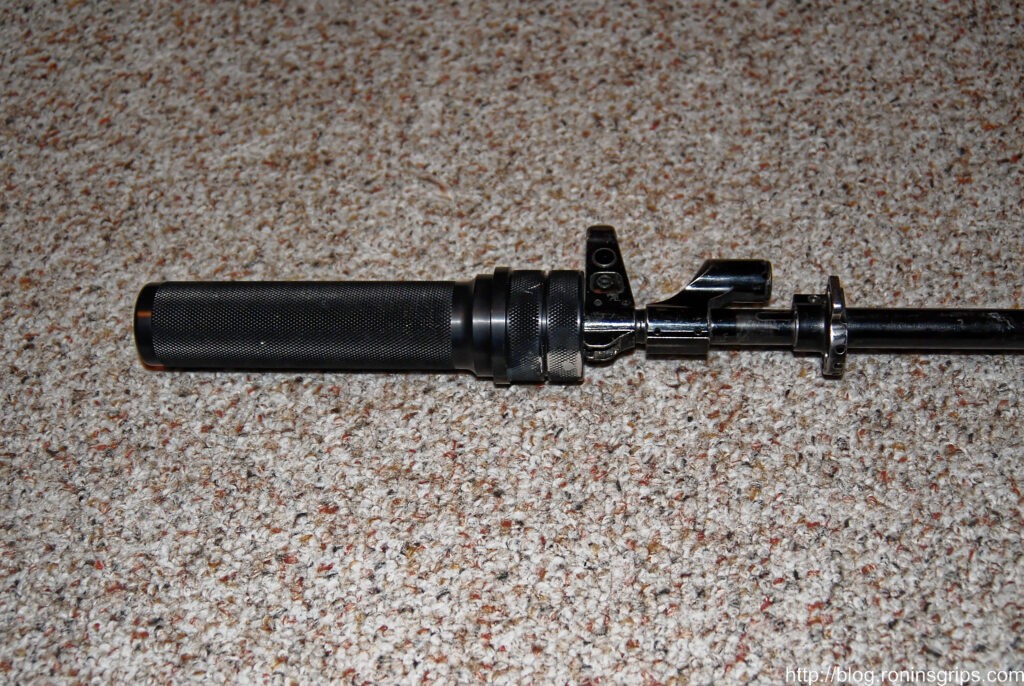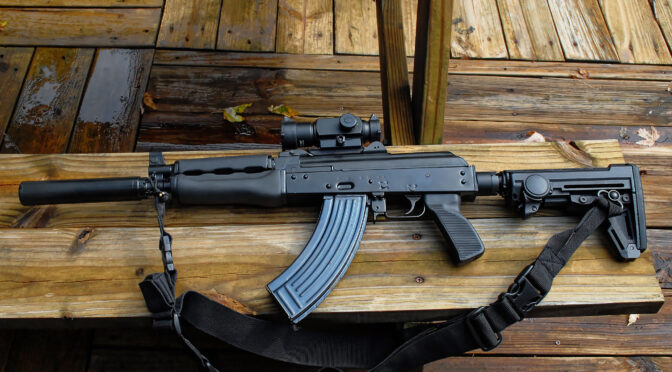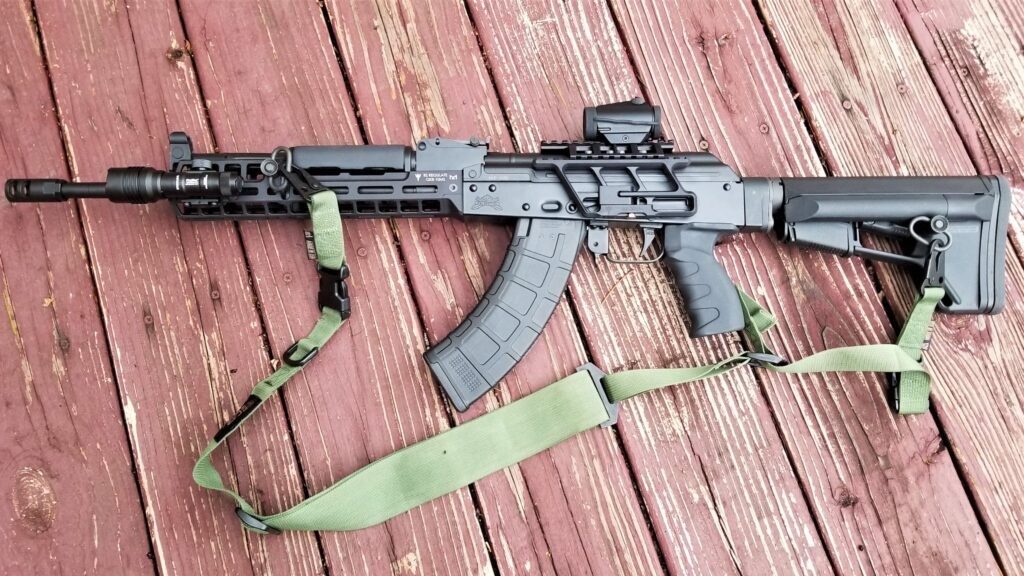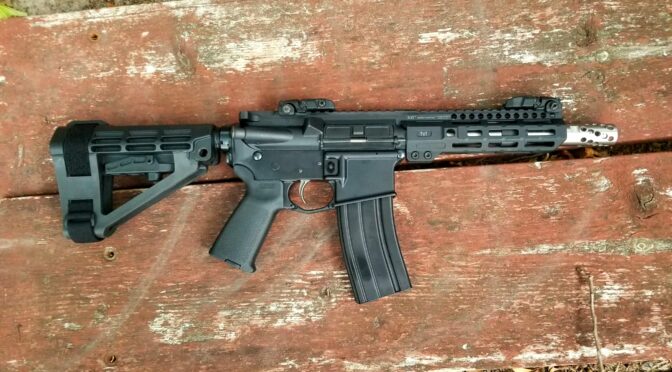| Please note that I am not an attorney and this is not legal advise. It is critical that you read the actual final rule and follow it as well as any state or local laws that might apply. |
Well, on Friday, January 13th, 2023, the ATF decided to post their final ruling on stabilizing braces. My first blog post was about this rule and options. As folks try to figure out what they are going to do, one option is to do something with the barrel so it will be considered a rifle. This blog post is about that and may be far easier than you think.
Let’s start by looking at the exact text from the final rule located on page 272: “Remove the short barrel and attach a 16-inch or longer rifled barrel to the firearm, thus removing it from the scope of the NFA.” At issue is the barrel length – so let’s pick this apart.
Barrel length is measured by having the bolt closed, inserting a dowel down from the muzzle end of the barrel with any removable devices removed, marking the end of the barrel on the dowel and then measuring the result. The bold italics text is for any barrel with a removable device such as a muzzle brake. They are not taken into account when it comes to barrel length. (Page 18 (printed page 6) of the linked to NFA PDF file on the ATF website states “Barrels are measured by inserting a dowel rod into the barrel until the rod stops against the bolt or breech-face. The rod is then marked at the furthermost end of the barrel or permanently attached muzzle device, withdrawn from the barrel, and measured.”
While the Gun Control Act specifies the barrel must be at least 16″ for a rifle, most manufacturers or folks modifying firearms target a length of 16.5″ to avoid an accidental NFA violation. The penalties for violating the NFA are always severe so always go past the minimums.
In case you are wondering about the barrel swap option and why it exists, it’s been the case for quite a while that a pistol can be turned into a rifle. The following is from the ATF’s website:
Assuming that the firearm was originally a pistol, the resulting firearm, with an attached shoulder stock, is not an NFA firearm if it has a barrel of 16 inches or more in length.
Pursuant to ATF Ruling 2011-4, such rifle may later be unassembled and again configured as a pistol. Such configuration would not be considered a “weapon made from a rifle” as defined by 26 U.S.C. § 5845(a)(4).
With this in mind, that a pistol can be turned into a rifle, which is what we want to do, you have two options – permanently attach a muzzle device or replace the barrel. Let’s explore both options.
Option 1: Permanently Attach A Sufficiently Long Muzzle Device to get 16.5″
The Final Rule on braces says that one option to avoid having the braced pistol be considered a NFA controlled short barreled rifle (SBR) is to replace the barrel with one that is at least 16″. Builders in the AK and AR communities have long used permanently attached extended muzzle brakes or barrel extensions to get the barrel to the length they want (Personally, I go for 16.5″ because I like having a safety margin.
| You will notice I am using “extension”, “muzzle device” and “extended muzzle device”. They are related but can be different. There is such a thing as barrel extensions that are a steel tube with male threads on one end and female threads on another. Muzzle devices are the broad category for anything that goes on the muzzle end including brakes. Extended brakes are stretched to purposefully take care of the length required while doing something to quell recoil. You can do any of these or combine them but they must be permanently attached so let’s review that |
This next part is critical – the extension must be permanently attached and there is long-standing ATF guidance on this. To be considered permanent per the current ATF guidance (page 18 (printed page 6) of the linked ATF NFA PDF document – be sure to read it), a muzzle device must be attached via one of the following three methods:
- Welded all the way round the barrel-to-device circumference (attention old-timers, they now use the term “full fusion gas or electric steel-seam welding”. The use of a fusion welding method half way around the circumference or four equidistant welds may no longer be acceptable)
- Blind pinned meaning you drill a hole through the brake, part way into the barrel, a pin is inserted and then welded over. This can be done in such a way that it is practically invisible when done.
- High temperature (1100F) silver solder – this is brazing solder to be very. This is not low-temp plumbing silver solder. Do NOT use regular solder.
These are the only three approved methods that you can use. Epoxy, rusting, any form of adhesive – they are not acceptable to the ATF and you will be found in violation of the GCA rifle length of 16″ if you use them. Ignorance of the law is not a defense. You must use one of those three for it to be considered permanent.
This is quick, easy and relatively cheap and I used blind bins because I thought the resulting “looks” were cleaner plus it allowed me to attach an aluminum fake can to a steel barrel (you can’t weld dissimilar metals like those two).
In short, there is clear published ATF guidance that says adding a permanent extension works – it’s not a loophole and perfectly acceptable. If you have any concerns, then have a gunsmith do the work.

By the way, let’s talk the math needed to get the correct length of extension or muzzle device for just a minute. Measure your barrel with a dowel with the bolt closed. Let’s say it’s 12.5″ and if you want it to be 16.5″ long the difference is 4″. What length extension do you need? This is where you need to know how long the thread of your barrel is and how far it will go into the muzzle device before it stops. If the device will overlap the barrel by 0.5″ then you are right at 16″ not the desired 16.5″. You must factor in that overlap! So, if we want 16.5″ of barrel length – 12.5″ currently = 4″ + 0.5″ overlap then you need a muzzle device that is 4.5″ long. It never hurts to be a tad over in barrel length but you never want to be short. Read about the fitment before you buy is the bottom line. If the muzzle device requires a backing nut / “jam” nut to secure it, that goes into the planning.
Device length = 16.5″ – current length + overlap device and jam nut if used
I would recommend steel muzzle devices if you have the choice. Steel devices stand up to the heat and muzzle blast better than aluminum. If all you can find is aluminum for your application or you want something that looks like a fake can or whatever then go ahead. Steel does get heavy fast so some larger devices intentionally use aluminum to avoid the weight.
You have lots of options – muzzle devices are attached by the thread so to buy one you look at the thread on your barrel (such as 1/2×28 or 14x1LH, etc.), the caliber (5.56, 9mm, 7.62, etc.) and the length you need. You do not need to buy something special for a 5.56/.223 AR for example – you would search 1/2×28, .223 or 5.56, and then the length. There are tons of weapons that use those.
The caliber is really important because you can have far larger calibers using 1/2×28 that will not fit through a smaller .223 brake. 9mm is one example. Also, you may know a caliber but also need to check the thread because the builder may have picked a different thread pattern.
Interestingly enough, there are tons and tons of muzzle devices on eBay (click here for a search I set up) – I think partly because a lot of small machine shops realize they can crank out a brake plus you have tons of people importing them as well.
In all cases, just remember to confirm the threading, caliber and desired length before you go shopping and certainly before you install and test fire the weapon.
Option 2: Replace the barrel – In some cases it is really easy to do
This is the verbatim guidance from the final brace rule. On some weapons platforms, such as the AR, replacing the barrel is very easy. On others, such as the AK, it can be done but it is far more involved and you wind up paying for quite a bit of labor. There are also ones that are far easier than you may think such as bolt action rifles so it pays to do some research and ask around.
On the plus side you may pick up some velocity with the longer barrel and if you get a higher quality barrel, you may even get some accuracy improvements. I have to word it that way because all things being equal, longer barrels have velocity gains but if they are of equivalent quality, length does not improve accuracy … unless you tell me the short barrel can’t stabilize what you are shooting. Sigh … barrels & ballistics will always start an argument. I’m trying to point out that going with a longer barrel is not always doom and gloom with no gains.
In addition to the barrel, don’t forget about overall length either – a rifle must be at least 26″
The ATF defines overall length as “The overall length of a firearm is the distance between the muzzle of the barrel and the rearmost portion of the weapon measured on a line parallel to the axis of the bore.” — per page 2 (printed page 6) of the NFA PDF linked to at the ATF.
The minimum overall length of a rifle is 26″. Now things get squirrely between state and federal governments as to how overall length is measured when it comes to folding stocks. Is it done with the stock deployed and fully extended or when it is closed? You will need to find out which applies to you.
The ATF’s position is to measure the overall length with the stock folded per a 2019 ATF letter obtained and shared by Prince Law. I never was a huge folder fan –my preference are the M4 style collapsing stocks. They tend to have better ergonomics for the cheek weld, flexible length of pull and are considerably longer than a folded “folder” when the M4 stock is compressed usually making the overall length a non-worry.
So, overall minimum length needs to be at least 26″. End of the day, it’s your decision about how you meet it but you need to plan for it via some combination of barrel length and stock.
What about 922(r) compliance for foreign rifles?
To begin, let’s look at the law directly from house.gov concerning 922(r):
(r) It shall be unlawful for any person to assemble from imported parts any semiautomatic rifle or any shotgun which is identical to any rifle or shotgun prohibited from importation under section 925(d)(3) of this chapter as not being particularly suitable for or readily adaptable to sporting purposes except that this subsection shall not apply to-
(1) the assembly of any such rifle or shotgun for sale or distribution by a licensed manufacturer to the United States or any department or agency thereof or to any State or any department, agency, or political subdivision thereof; or
(2) the assembly of any such rifle or shotgun for the purposes of testing or experimentation authorized by the Attorney General.
What follows is my opinion and is not legal guidance – because the 922(r) compliance pertains to the assembling of rifles from foreign parts – it does not apply to domestically manufactured weapons using domestic parts – an AR fully made in the US from US parts is not within the scope of 922(r).
What I would tell you is that the any imported pistols were approved for importation and registered with the ATF as pistols. The receivers to be specific were recorded as pistols and still are pistols. In other words, even with the weapons configured as rifles, the receivers are still registered as pistol receivers with the ATF and thus not subject to 922(r). In the eyes of the ATF, the receiver classification is what matters.
To be perfectly clear, this is my opinion, I am not a lawyer and this is not legal advice. What really matters is what we hear from the ATF as this progresses. Don’t hold your breath though as they may never provide additional guidance on this – the ATF frequently leaves things vague and open for interpretation.
1/21/2023 Update: The Final Rule is such a mess that we all need to act and not let it pass. If you aren’t a member of Gun Owners of America (GOA), I recommend them. This rule has a fatal flaw that will trap gun owners and must not pass. Be sure to watch the following video of an interview with Steven – an attorney with GOA – who was at the SHOT show:
Summary
To meet the 16″ minimum barrel requirements you can replace your barrel with one that is at least 16.5″ long or extend your barrel with a permanently attached muzzle device so it is at least 16.5″ long. Find out which works best for you in terms of costs, looks and performance. Also, be sure to consider your overall length as part of your planning and revise your weapon accordingly.
Where to go for parts?
I’ll just list AK and AR websites – for others you will need to do some searching:
First off – parts and tools overall – check out Brownells.
AK parts vendors
AR parts vendors
If you find this post useful, please share the link on Facebook, with your friends, etc. Your support is much appreciated and if you have any feedback, please email me at in**@*********ps.com. Please note that for links to other websites, we are only paid if there is an affiliate program such as Avantlink, Impact, Amazon and eBay and only if you purchase something. If you’d like to directly contribute towards our continued reporting, please visit our funding page.


